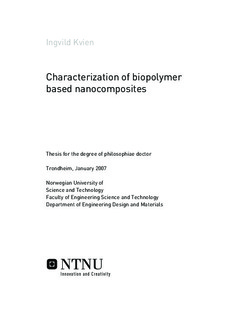| dc.contributor.author | Kvien, Ingvild | nb_NO |
| dc.date.accessioned | 2014-12-19T12:25:58Z | |
| dc.date.available | 2014-12-19T12:25:58Z | |
| dc.date.created | 2007-03-29 | nb_NO |
| dc.date.issued | 2007 | nb_NO |
| dc.identifier | 122238 | nb_NO |
| dc.identifier.isbn | 978-82-471-0251-0 | nb_NO |
| dc.identifier.uri | http://hdl.handle.net/11250/241289 | |
| dc.description.abstract | The field of nanocomposites is gaining considerable attention due to its potential for providing new materials with extraordinary physical properties compared to traditional composite materials. In this thesis cellulose nanowhiskers (CNW) were separated from microcrystalline cellulose (MCC) and dispersed in different biopolymer matrices to obtain polymer nanocomposites based on renewable resources. Moving from microstructure to nanostructure creates new challenges for structure characterization of materials. The overall aim of this work was to characterize the structure of CNW and their nanocomposites with different matrices. The sample preparation and microscopic examination of the bionanocomposites showed to be challenging because they are non-conductive, soft and water sensitive materials and consist of low atomic number elements. In the studies field emission scanning electron microscope was found to be a convenient and important first step in the analysis of the nanocomposite structure. More detailed information about the distribution of CNW was however obtained using transmission electron microscope (TEM) and atomic force microscope. X-ray diffraction analysis showed that the MCC consisted of both amorphous and crystalline regions. The sulfuric acid isolation treatment removed the amorphous regions and separated the cellulose nanowhiskers. From TEM analysis the size of the whiskers was measured to be 210 ± 75 nm in length and 5 ± 2 nm in width. It was also possible to separate the CNW from MCC using dimethyl acetamide containing a small amount of LiCl. It was however difficult to remove the organic solvent after treatment. CNW were well distributed in a hydrophobic matrix by the aid of a surfactant. Untreated CNW or untreated layered silicates in a thermoplastic starch matrix resulted in well dispersed nanocomposites. It was further found that it was possible to obtain oriented CNW in a matrix after exposure to a magnetic field. The dynamic mechanical thermal analysis of the different nanocomposites in this thesis showed that well dispersed cellulose whiskers have a large potential for improving the thermal mechanical properties of biopolymers. | nb_NO |
| dc.language | eng | nb_NO |
| dc.publisher | Fakultet for ingeniørvitenskap og teknologi | nb_NO |
| dc.relation.ispartofseries | Doktoravhandlinger ved NTNU, 1503-8181; 2007:12 | nb_NO |
| dc.title | Characterization of Biopolymer Based Nanocomposites | nb_NO |
| dc.type | Doctoral thesis | nb_NO |
| dc.contributor.department | Norges teknisk-naturvitenskapelige universitet, Fakultet for ingeniørvitenskap og teknologi, Institutt for produktutvikling og materialer | nb_NO |
| dc.description.degree | PhD i produktutvikling og materialer | nb_NO |
| dc.description.degree | PhD in Engineering Design and Materials | en_GB |
